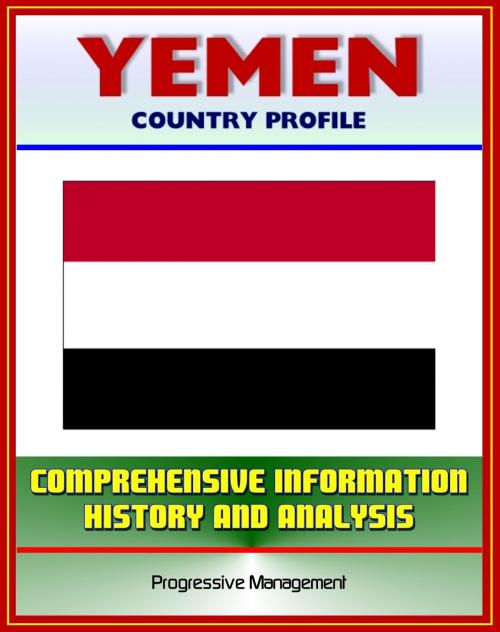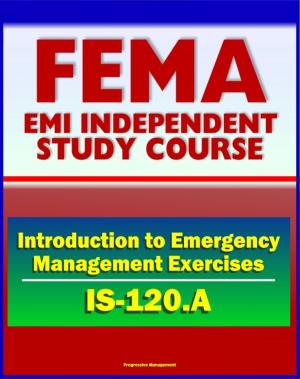Yemen: Profile with Comprehensive Information, History, and Analysis - Politics, Economy, Military - Sanaa, Treaty of Jiddah, Islam, President Ali Abdallah Salih
Nonfiction, Social & Cultural Studies, Political Science, International| Author: | Progressive Management | ISBN: | 9781458013736 |
| Publisher: | Progressive Management | Publication: | February 11, 2011 |
| Imprint: | Smashwords Edition | Language: | English |
| Author: | Progressive Management |
| ISBN: | 9781458013736 |
| Publisher: | Progressive Management |
| Publication: | February 11, 2011 |
| Imprint: | Smashwords Edition |
| Language: | English |
Comprehensive and unique information with professional analysis of Yemen. Yemen is located in the Middle East at the southern tip of the Arabian Peninsula between Oman and Saudi Arabia. It is situated at the entrance to the Bab el Mandeb strait, which links the Red Sea to the Indian Ocean (via the Gulf of Aden) and is one of the most active and strategic shipping lanes in the world. A long-standing dispute between Saudi Arabia and Yemen was resolved in June 2000 with the signing of the Treaty of Jiddah. This agreement provides coordinates for use in delineating the land and maritime border, including the section in the eastern desert region of Yemen that potentially contains significant amounts of oil. Friction between the two countries in recent years over security of the borders appears to have been alleviated by the establishment of joint border patrols. However, in early 2008 Saudi Arabia reinforced its concrete-filled security barrier along sections of the border in order to stem illegal cross-border activities. Following the civil war, Yemen’s currency, the riyal, was devalued; the cost of fuel doubled, water and electricity were in short supply, and food costs rose. Public demonstrations ensued, and the YIP was at odds with the GPC over economic reforms recommended by the World Bank. In the April 1997 parliamentary elections, the GPC garnered 187 seats and the YIP only 53 seats. A new Council of Ministers composed primarily of GPC members was named in May. The country continued to experience unrest due to economic hardship, coupled with increasing lawlessness, particularly against tourists. In September 1999, the first direct presidential election was held, reelecting the incumbent, President Salih, to a five-year term by an overwhelming margin. Constitutional amendments adopted in 2000 extended the president’s term by two years. President Salih was reelected in September 2006. In October 2007, he announced comprehensive political reforms, some of which will not take effect until he is no longer in power, calling into question the prospects for implementation. The September 2006 elections for local and governorate council seats, as well as the May 2008 elections for governorate governors have left power largely in the hands of the ruling GPC. * This is a privately authored news service and educational publication of Progressive Management. Our publications synthesize official government information with original material - they are not produced by the federal government. They are designed to provide a convenient user-friendly reference work to uniformly present authoritative knowledge that can be rapidly read, reviewed or searched. Vast archives of important data that might otherwise remain inaccessible are available for instant review no matter where you are. This e-book format makes a great reference work and educational tool. There is no other reference book that is as convenient, comprehensive, thoroughly researched, and portable - everything you need to know, from renowned experts you trust. For over a quarter of a century, our news, educational, technical, scientific, and medical publications have made unique and valuable references accessible to all people. Our e-books put knowledge at your fingertips, and an expert in your pocket!
Comprehensive and unique information with professional analysis of Yemen. Yemen is located in the Middle East at the southern tip of the Arabian Peninsula between Oman and Saudi Arabia. It is situated at the entrance to the Bab el Mandeb strait, which links the Red Sea to the Indian Ocean (via the Gulf of Aden) and is one of the most active and strategic shipping lanes in the world. A long-standing dispute between Saudi Arabia and Yemen was resolved in June 2000 with the signing of the Treaty of Jiddah. This agreement provides coordinates for use in delineating the land and maritime border, including the section in the eastern desert region of Yemen that potentially contains significant amounts of oil. Friction between the two countries in recent years over security of the borders appears to have been alleviated by the establishment of joint border patrols. However, in early 2008 Saudi Arabia reinforced its concrete-filled security barrier along sections of the border in order to stem illegal cross-border activities. Following the civil war, Yemen’s currency, the riyal, was devalued; the cost of fuel doubled, water and electricity were in short supply, and food costs rose. Public demonstrations ensued, and the YIP was at odds with the GPC over economic reforms recommended by the World Bank. In the April 1997 parliamentary elections, the GPC garnered 187 seats and the YIP only 53 seats. A new Council of Ministers composed primarily of GPC members was named in May. The country continued to experience unrest due to economic hardship, coupled with increasing lawlessness, particularly against tourists. In September 1999, the first direct presidential election was held, reelecting the incumbent, President Salih, to a five-year term by an overwhelming margin. Constitutional amendments adopted in 2000 extended the president’s term by two years. President Salih was reelected in September 2006. In October 2007, he announced comprehensive political reforms, some of which will not take effect until he is no longer in power, calling into question the prospects for implementation. The September 2006 elections for local and governorate council seats, as well as the May 2008 elections for governorate governors have left power largely in the hands of the ruling GPC. * This is a privately authored news service and educational publication of Progressive Management. Our publications synthesize official government information with original material - they are not produced by the federal government. They are designed to provide a convenient user-friendly reference work to uniformly present authoritative knowledge that can be rapidly read, reviewed or searched. Vast archives of important data that might otherwise remain inaccessible are available for instant review no matter where you are. This e-book format makes a great reference work and educational tool. There is no other reference book that is as convenient, comprehensive, thoroughly researched, and portable - everything you need to know, from renowned experts you trust. For over a quarter of a century, our news, educational, technical, scientific, and medical publications have made unique and valuable references accessible to all people. Our e-books put knowledge at your fingertips, and an expert in your pocket!















